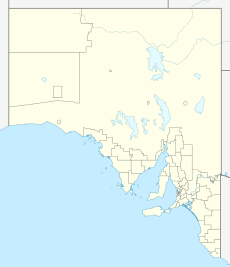world.wikisort.org - Australia
Eurilla Conservation Park was a protected area located in the Australian state of South Australia in the suburb of Crafers in the Adelaide Hills state government region about 11 kilometres (6.8 mi) south-east of the state capital of Adelaide and about 2.4 kilometres (1.5 mi) north of the town centre in Stirling.[2][5] It was merged with the adjoining Cleland Conservation Park to become a national park called Cleland National Park on 26 November 2021.[6]
| Eurilla Conservation Park South Australia | |
|---|---|
IUCN category III (natural monument or feature)[1] | |
 Eurilla Conservation Park | |
| Nearest town or city | Stirling[2] |
| Coordinates | 34°58′57″S 138°42′43″E[1] |
| Established | 22 September 1977[3] |
| Area | 7 hectares (17 acres)[4] |
| Managing authorities | Department for Environment and Water |
| See also | Protected areas of South Australia |
The conservation park consisted of land in section 535 in the cadastral unit of the Hundred of Onkaparinga, located to the east of the Mount Lofty Summit Road about 1 kilometre (0.62 mi) south of the summit of Mount Lofty and bounded on its northern boundary by the Cleland Conservation Park.[2] It was proclaimed under the National Parks and Wildlife Act 1972 on 22 September 1977.[3] As of 2016, it covered an area of 7 hectares (17 acres).[4]
In 1980, it was described as follows:[5]
The main feature, and reason for dedication of the park, is an undisturbed bog consisting of a dense mat of the rare coral fern (Gleichenia microphylla) and a sizeable colony of mature king fern (Todea barbara), an endangered species in South Australia. These specimens are amongst the finest in the state. An excellent bog habitat surrounded by Eucalyptus obliqua open forest over an open shrub stratum of Exocarpos cupressiformis, Banksia marginata and Pultenaea daphnoides. A dense ground stratum consists of a wide variety of herbs, grasses and forbs. There are many fallen logs in various stages of decay together with a substantial accumulation of forest litter. The park is substantially undisturbed and surrounded by native vegetation on three sides. This area has not been burnt since 1920, and suffers only minor influence from introduced species.
The conservation park was classified as an IUCN Category III protected area.[1] In 1980, it was listed on the now-defunct Register of the National Estate.[5]
See also
- Protected areas of South Australia
References
- "Terrestrial Protected Areas of South Australia (refer 'DETAIL' tab )". CAPAD 2016. Australian Government, Department of the Environment (DoE). 2016. Retrieved 21 February 2018.
- "Search results for 'Eurilla Conservation Park' with the following datasets selected – 'Suburbs and Localities', 'Government Towns', 'Metropolitan Adelaide Boundary (Development Act 1993)', 'SA Government Regions', 'NPW and Conservation Boundaries', 'Roads', 'Recreational Trails' and 'Gazetteer'". Location SA Map Viewer. South Australian Government. Retrieved 2 April 2018.
- Banfield, B.H. (22 September 1977). "NATIONAL PARKS AND WILDLIFE ACT, 1972-1974: CONSERVATION PARK CONSTITUTED" (PDF). South Australian Government Gazette. South Australian Government. p. 807. Retrieved 2 April 2018.
- "Protected Areas Information System Reserve List" (PDF). Government of South Australia. 14 December 2016. Archived from the original (PDF) on 3 August 2017. Retrieved 27 December 2017.
- "Eurilla Conservation Park – listing on the now-defunct Register of the National Estate (Place ID 6578)". Australian Heritage Database. Australian Government. 1980. Retrieved 2 April 2018.
- Speirs, David (26 November 2021). "SA now home to Australia's biggest national park". Premier of South Australia. Retrieved 19 December 2021.
 This article incorporates text by Commonwealth of Australia available under the CC BY 3.0 AU licence.
This article incorporates text by Commonwealth of Australia available under the CC BY 3.0 AU licence.
External links
- Eurilla Conservation Park on the Protected Planet website
- Eurilla Conservation Park on the BirdsSA website
Другой контент может иметь иную лицензию. Перед использованием материалов сайта WikiSort.org внимательно изучите правила лицензирования конкретных элементов наполнения сайта.
WikiSort.org - проект по пересортировке и дополнению контента Википедии